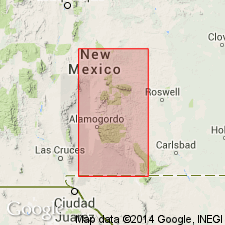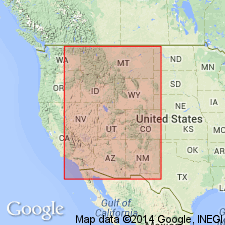
- Usage in publication:
-
- Caballero formation
- Modifications:
-
- Named
- Dominant lithology:
-
- Limestone
- Marl
- AAPG geologic province:
-
- Orogrande basin
Summary:
Named; derivation of name not stated. Report area is west face of Sacramento Mountains, Otero Co, NM, Orogrande basin. Type area designated in Deadman Canyon, sec 3, T17S, R10E, Otero Co, where section measured. Mississippian formations are underlain by Percha formation of Late Devonian age; Mississippian rocks previously called Percha here removed from Percha and divided into: lowermost Caballero formation (here named); and uppermost Lake Valley formation (revised), itself newly divided into three members (ascending): Alamogordo, Arcente, and Dona Ana members. Caballero consists of gray, nodular, argillaceous limestone grading upward into gray, nodular marl with interbedded shaly lenses. Very fossiliferous locally. Unconformably overlain by Lake Valley's lower, Alamogordo member, which contains a large amount of reworked Caballero sediments; overlies Devonian strata [Percha, as here revised] unconformably. Large fauna contained in Caballero indicates Kinderhookian age. Correlated most closely with Chouteau of Upper Mississippi Valley region. Mississippian beds in Sacramento Mountains area are better developed than in Lake Valley area at Lake Valley, Otero Co, Orogrande basin. Caballero formation is present in both areas, but Lake Valley beds at Lake Valley are all correlated with Alamogordo member as developed in Sacramento Mountains. Arcente and Dona Ana members not present at Lake Valley. Is Kinderhookian (Mississippian) age.
Source: GNU records (USGS DDS-6; Denver GNULEX).

- Usage in publication:
-
- Caballero formation
- Modifications:
-
- Contact revised
- Areal extent
- AAPG geologic province:
-
- Orogrande basin
Summary:
Upper contact of Caballero formation revised in southern NM. Overlying Lake Valley formation (revised) is divided into (ascending): Andrecito (new), Alamogordo (revised), Nunn (new), Tierra Blanca (new), Arcente, and Dona Ana members. Contact with overlying Andrecito member of Lake Valley is unconformable. Overlies Devonian rocks unconformably. Caballero is retained as originally defined (Laudon, Bowsher, 1941). Is best developed in Sacramento Mountains (Otero Co, NM, Orogrande basin), occurs in central part of San Andres Mountains (Dona Ana Co, NM, Orogrande basin), and occurs locally in the Lake Valley area (Sierra Co, NM, Orogrande basin). Elsewhere in NM it is missing. Lithologic characteristics and fauna indicate that Caballero is equivalent to Chouteau formation of the Mississippi Valley area. Measured sections, cross sections, areal extent maps.
Source: GNU records (USGS DDS-6; Denver GNULEX).

- Usage in publication:
-
- Caballero Formation
- Modifications:
-
- Age modified
- AAPG geologic province:
-
- Orogrande basin
Summary:
Is formation of Laudon and Bowsher (1949). Ammonoids described from several localities in Sacramento Mountains of south-central NM in Orogrande basin. Material includes specimens of PERICYCLUS (GONIOCYCLUS) BLAIRI, P. (G.) COOPERI n. sp., P. (G.) COSTULATUS n. sp., and GATTENDORFIA BRANSONI. Caballero is middle to late Kinderhookian in age, as determined from its conodont and brachiopod faunas. Lane (1974, p. 270, 272, 277) has shown that the Caballero coincides with his faunal unit 1, beginning in the SIPHONODELLA SANDBERGI-S. DUPLICATA Zone (Sandberg and Klapper, 1967, p. B47) and extending through the lower part of the SIPHONODELLA COOPERI HASSI Subzone of Thompson and Fellows (1970, p. 56). The ammonoids themselves indicate a late Kinderhookian age.
Source: GNU records (USGS DDS-6; Denver GNULEX).
For more information, please contact Nancy Stamm, Geologic Names Committee Secretary.
Asterisk (*) indicates published by U.S. Geological Survey authors.
"No current usage" (†) implies that a name has been abandoned or has fallen into disuse. Former usage and, if known, replacement name given in parentheses ( ).
Slash (/) indicates name conflicts with nomenclatural guidelines (CSN, 1933; ACSN, 1961, 1970; NACSN, 1983, 2005, 2021). May be explained within brackets ([ ]).

